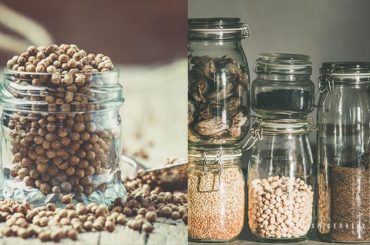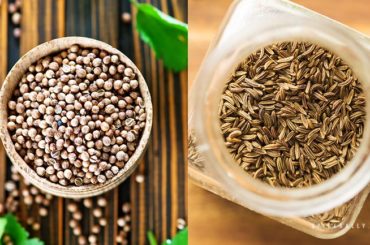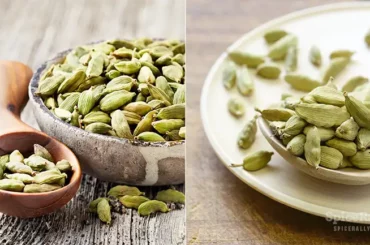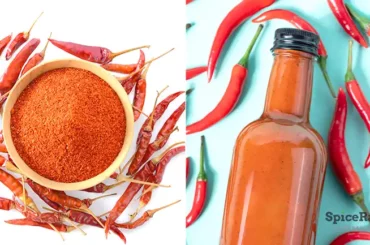Coriander, also popular as cilantro in the USA, and oregano are two herbs that add maximum flavor to your food. But, the difference between coriander and oregano can be counted, and they act diversely in various dishes.
Coriander (or cilantro) and oregano can be mainly different in shapes, flavors, cooking usage, and nutritional value. However, they both are gifts of nature packed with herbal essence and health benefits.

In this detailed feature, we will be addressing everything regarding coriander vs oregano. So, if you ever had any doubts about the differences and similarities between these two herbs while cooking, we have answers right here!
Coriander Vs Oregano- What’s The Real Difference?
Before explaining anything, initially, we should say that both of these plants belong to the culinary herbs category. Coriander or oregano, both would be excellent flavor enhancers that add flavor, texture, aroma, and nutritional importance to any dish they call for.
So is this all about these two herbs? Obviously not. Check out the table below for a clear elaboration on each and every difference between coriander and oregano.
| Coriander | Oregano | |
| Flavor profile | Citrusy, subtle, and pungent with a fresh bite. (Soapy tasting to some) | It has a flavor of a delicate balance between sweet and spicy. It is proactive and earthy with a slightly astringent taste that reminds the fragrant organic compound camphor. |
| Fragrance profile | Lightly citrusy, earthy, refreshing (soapy smelling to some) | Sweet, minty, earthy, and fresh. |
| Forms using and available | As a dried herb or fresh leaves and stalks. | As a dried herb or fresh leaves. (The dried form is common) Dried oregano ranges from light brown, green to darker green. |
| Dishes or foods that pair well | Avocados olives Lime Fried rice Salsa Salad dressings Chutneys Stir-fries Dips Green sauces Oil infusions | Pizza pasta sauce Olive oil-centric dishes Garlic Basil Thyme Onion Chicken Beef lamb Marinades Italian vinaigrettes In oil infusions Eggplant Zucchini Cauliflower |
| Culinary Use | A herb Best for with slow cooking Used chopped As a garnish | A herb Best with tomato-based recipes Italian dishes Used torn or chopped As a garnish |
| Availability | Widely available in both dried and fresh forms in leading supermarkets, local grocers, and online sellers. | Widely available in the dried form. Fresh leaves can also be purchased from leading supermarkets, grocery stores, and online sellers. |
| Other names | Cilantro, Chinese parsley, dhania | Sometimes called Wild Marjoram |
| Price | A fresh bunch of cilantro costs about $0.96 A 0.4 oz dried cilantro container costs around $4 | A 0.75 oz of packaging of oregano costs around $2 A 0.75 oz container of dried oregano costs around $3 |
| Shelf Life | Fresh cilantro stays about 7-10 in when properly stored and refrigerated. Dried cilantro stays about 1-3 years. | When stored and appropriately refrigerated, fresh oregano stays about three days. Dried oregano could last up to 2-3 years. |
| Health benefits | Beneficial for digestive issues Alleviates nausea Lowers blood sugar Improves heart health Helps with cognitive function and brain-rated health issues. Potential benefits in the absorption of heavy metals of mercury-laden foods. Protects against Candida and Salmonella. | Potential protection against bacteria Rich in antioxidants It helps to reduce viral infections It May contain anti-cancer properties Reduces inflammation Oregano oil is a natural antibiotic Improves gut health Could relieve pain |
| Nutrition per 100g | 23 cal 2.13 g of protein 3.67g of carbohydrates 0.52 fat | 306 cal per 11g of protein 64.43g of carbohydrates 10.25 fat |
| Main featuring cuisines | Asian, North African, European, Middle Eastern. | Italian, Mexican, Greek, Spanish, French, Turkish |
| Appearance | Lacy, flat green leaves with long stalks. | It can be woody or herbaceous and have numerous branching stems. The leaves are oval or round and are positioned alternately on the stalks. |
| Harvesting | Coriander plant is cut about one-third down from the top, and the remaining two-third is kept to grow new leaves. | Usually, oregano is harvested once the stems grow up to 4-5 inches tall or right before it blooms. |
| Scientific name | Coriandrum sativum | Origanum vulgare |
| Plant Family | Apiaceae | Lamiaceae |
| Origin | Not precisely verified. | Native to the elevations of Western Asia and the Mediterranean countries and has assimilated in parts of Mexico and the United States. |
Coriander is popularly known as cilantro in the USA. And, it is basically the leaves and stalks of this plant we refer to when we say “coriander” or “cilantro”. This plant usually bears its babies- coriander seeds. Interestingly, all the parts of the coriander plant are edible, including the roots, which get featured in many Thai dishes. Although cilantro or coriander leaves are considered a herb, coriander seeds fall into the class of spices.
If you feel like this bit of information is not enough about coriander, don’t worry. Just click here and you will be directed to a fully detailed article about everything you need to know about coriander.
Meanwhile, oregano comes with less sophistication! In fact, it bears no babies (fruits that are edible) and generally does not have name variations. And, it is just simply “oregano” everywhere in the world. While coriander or cilantro is referred to as both the leaves and stalks, oregano is merely about the eaves of its plant.
Can You Use Coriander In Place Of Oregano And Vice Versa?
After learning the comparison table closely, the next big question you might have is about substituting coriander with oregano and the other way round.
With regard to the flavor, aroma, and texture profiles, the experts say that oregano alone cannot be a good substitute for coriander, and it goes the same vice versa.
But marjoram could be the next best option if you want to replace oregano. Since oregano is sometimes called wild marjoram, this herb could be your best bet.
However, the flavor of marjoram is much more delicate and floral than that of oregano. And, the next best choice to replace oregano would be thyme.
When talking in terms of coriander or cilantro, you will have to go for herbs that go well with slow cooking, just like coriander. Likewise, parsley could be an absolute lifesaver. In fact, Coriander leaves and parsley are closely related, sharing the same family. So, if anything that could replace coriander, parsley would be the best!
9 Coriander substitutes – There are some other substitutes that you can use in place of coriander. To learn about all of them, click here for a complete article.
Coriander Vs Oregano- Usage In Cooking
As mentioned above, coriander and oregano both are powerful and flavorful herbs that could add so much taste to your meals.
However, oregano has marked its place in Italian cuisine as the Italian dishes are featured with tomatoes and olive oil in most cases. This herb is also a good companion in Greek dishes. Most meat and seafood recipes call for oregano and are also a must-have in pizzas.
Unlike any other herb, oregano will not de-intensify its flavor when dried. In fact, the best version of this herb is its dried form.
While on the other hand, cilantro goes well with slow-cooked and fresh dishes. Most salad dressings, vinaigrettes, fresh salads, and rice dishes call for cilantro or coriander leaves.
Herbs are the friend of the physician and the pride of cooks
Charlemange
Coriander leaves tend to lose their flavor and nutrition when cooked with recipes that get simmered in high heat. Therefore, this herb is usually added with freshly made dishes or recipes that require a moderate cooking process.
Concluding The Battle Between Coriander Vs Oregano!
Despite the differences between coriander and oregano, both of these spices could actually take your meals to the next level.
However, they are different in shape, flavor, aroma, and also in nutritional aspects. Both of them are versatile and can be purchased as fresh and in dried forms.
Above all, you can grow them in your own home garden without much effort and dry them in your own kitchen. Now wouldn’t that sound great!
Since you discovered the differences and similarities between coriander and oregano, you may also like to learn about coriander vs parsley which are the most commonly confused herbs. Click here for a comprehensively detailed article on these two herbs.




